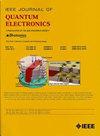High-Power Photodiodes With Optimized Electrode Design
IF 2.1
3区 工程技术
Q3 ENGINEERING, ELECTRICAL & ELECTRONIC
引用次数: 0
Abstract
we demonstrate a back-illuminated flip-chip bonded modified uni-traveling carrier photodiodes by optimizing coplanar waveguide on AlN to improve the bandwidth and output power of the photodiode. The 3-dB bandwidth of the optimized devices increased from 56 GHz to 67 GHz for the优化电极设计的大功率光电二极管
通过优化AlN上的共面波导,我们设计了一种背照倒装键合的单行载流子光电二极管,以提高光电二极管的带宽和输出功率。优化后器件的3db带宽从56 GHz增加到67 GHz,对于直径为14~\mu $ m的光电二极管,从39 GHz增加到46 GHz,两种情况下都提高了约20%。由于器件的高频性能得到改善,直径为22~\mu $ m和14~\mu $ m的光电二极管在30 GHz和65 GHz分别表现出23.8 dBm和17 dBm的高射频输出功率。直径为$14~\mu $ m的PD具有较低的相位噪声,在5 mA至50 mA的光电流范围内,RF信号的最大相位变化保持在10度以内。光产生的射频信号的相位噪声,由于光脉冲串上的幅值噪声与相位噪声(AM-PM)的耦合而加剧,在17 mA时表现为零。此外,采用直径22~\mu $ m光电二极管的全封装模块在40ghz时具有3db带宽和16.6 dBm的高RF输出功率。该研究为高性能微波光子学系统的发展和超低噪声微波信号的产生奠定了基础。
本文章由计算机程序翻译,如有差异,请以英文原文为准。
求助全文
约1分钟内获得全文
求助全文
来源期刊

IEEE Journal of Quantum Electronics
工程技术-工程:电子与电气
CiteScore
4.70
自引率
4.00%
发文量
99
审稿时长
3.0 months
期刊介绍:
The IEEE Journal of Quantum Electronics is dedicated to the publication of manuscripts reporting novel experimental or theoretical results in the broad field of the science and technology of quantum electronics. The Journal comprises original contributions, both regular papers and letters, describing significant advances in the understanding of quantum electronics phenomena or the demonstration of new devices, systems, or applications. Manuscripts reporting new developments in systems and applications must emphasize quantum electronics principles or devices. The scope of JQE encompasses the generation, propagation, detection, and application of coherent electromagnetic radiation having wavelengths below one millimeter (i.e., in the submillimeter, infrared, visible, ultraviolet, etc., regions). Whether the focus of a manuscript is a quantum-electronic device or phenomenon, the critical factor in the editorial review of a manuscript is the potential impact of the results presented on continuing research in the field or on advancing the technological base of quantum electronics.
 求助内容:
求助内容: 应助结果提醒方式:
应助结果提醒方式:


